Equipment Insight -- Telehandlers
Insight on telehandlers from AMS - Merlo, Xtreme/Snorkel, Genie, JCB, JLG, Manitou, Pettibone, Skyjack and Magni.
Telehandlers are increasingly becoming one of the first pieces on a job site and one of the last to leave. Their ability to pick and carry and pick and lift keep them busy on most job sites throughout the project. The models don’t fall into a one-size-fits-all category, though, so that means rental center representatives need to ask important application questions to assure the customer rents the model that can do the most jobs productively and safely.
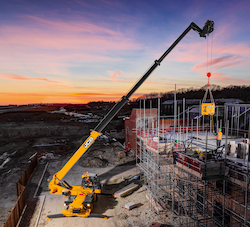 |
|
Rotating telehandlers are gaining in popularity on job sites. |
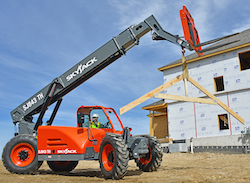 |
|
Using improved gearing and a high-efficiency hydraulics package, Skyjack’s TH Series’ 74-horsepower engines deliver the same on-site job performance as higher horsepower units. The SmarTorque engine is also engineered to require no DPF, DEF, or other active exhaust aftertreatment, which reduces operating costs. |
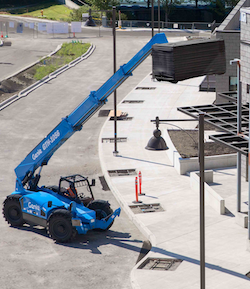 |
|
The 74-horsepower DEF-free engine option on Genie’s new GTH-1056 is a low-maintenance solution. Combined with Continuously Variable Transmission (CVT), this engine delivers performance on par with the 120-horsepower engine, but with a lower purchase cost and better fuel efficiency. |
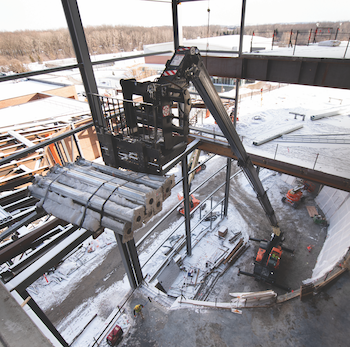 |
|
Telescopic handlers are tool carriers and with the correct attachments, the machine can move quickly from placing lumber with a fork carriage to setting trusses with a jib, lift hook or truss boom to moving gravel with a bucket to lifting people in a work platform to access high areas. |
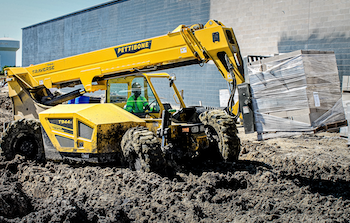 |
| Pettibone continues to be the only manufacturer producing a telehandler with a horizontally sliding boom. All models in the Pettibone Traverse lineup offer up to 70 inches of traversing boom travel. |
Pro Contractor Rentals asked telehandler experts on the trends they see customers are wanting from these units and how rental centers can achieve greater ROI on new units.
Visibility a strong selling point
Merlo telehandlers feature an Adaptive Stability Control System (ASCS), which is the latest in advanced telehandler safety and is a Merlo exclusive. This kind of safety technology ensures operators are always aware of the how a telehandler, in relation to its load and placement on the site, is functioning.
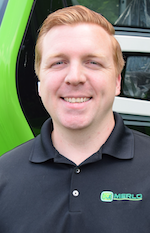 |
|
Austin Bailey |
The ASCS ensures anti-tip, which means an operator can be confident the telehandler is safe all the time.
For Merlo, select Plus models and the Roto telehandlers have a 10-inch screen monitor mounted on the dash. This screen shows the boom and its attachment, what the load weighs and what the boom can or cannot do with that load to assure load, equipment and operator safety.
Merlo booms are designed so they do not flex, which translates to a wider range of uses. It makes the booms capable of ground-engaging activity as well as using other types of attachments for more versatility on job sites.
Merlo booms have a low pivot point. The boom does not obscure an operator’s view and Merlo promotes this as a 360-degree view with visibility to the front, back, sides and roof. Operators can clearly see what they need to see to complete a load movement safely. Rental partners report the increased visibility is a strong selling point for the end user.
When considering bringing additional telehandler models into the fleet, consider ease of operation. How easy is it for an operator to get in, start the machine and get right to work? It may not be financially viable to have something in the rental fleet that has to be sent out with a product specialist or operator every time it is rented. The ASCS system assists the operator in running the equipment safely and helps prevent damage to the unit. The safety systems will stop the machine from tipping over, protecting the telehandler and the operator.
Rental centers can increase their telehandler ROI by educating sales teams so they can educate customers on these machines and their capabilities. Take advantage of any literature and sales training the telehandler distributor offers and take advantage of it often.
Telehandlers, just like cars and trucks, are constantly updated. Ensure the units are always in good working condition. Pay attention to the hours and each model’s maintenance requirements. Although you may not want to send out a product specialist with every machine rental, being able to offer on-the-job training is a caveat that could reap benefits.
Another way to increase demand and subsequent ROI is for rental centers is have an open house event whenever a new piece of equipment comes in so customers can get familiar with the unit and its capabilities. Having manufacturer reps available to explain and demonstrate the new equipment is a boon for everyone.
Technology improves safety serviceability and operator comfort
Xtreme Manufacturing developed Coordinated Motion to provide a safer option for operators looking to replace traverse booms that move the center of gravity due to overall boom sliding movement. Xtreme telehandlers utilize technology to track and assist with operator control when placing or picking a load by keeping the fork tines level while lifting or lowering. Older designs require the boom to slide to keep the horizontal reach level with the machine, making tasks difficult because many manual joystick adjustments are needed, especially on slopes.
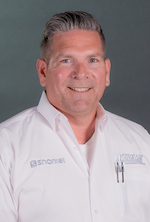 |
| Robby Hagan Senior Vice President, Sales Xtreme MFG./Snorkel |
LED screens provide important information, eliminating the need for individual mechanical gauges. An illuminated tire-position indicator helps the operator center the four tires without having to lean out of the cab when preparing to switch between steer modes. Warning lights that alert the operator to overheating, low tire pressure and battery health can also be seen on the large screen.
Telematics are another valuable tool. When more than one operator may utilize the same telehandler but not return it to the place it was originally parked, telematics can quickly locate the telehandler. It can also provide insight on other factors, such as remotely identifying the hour meter to schedule routine service and track usage.
Many operators are assigned to operate the same telehandler all day. Suspension seats, additional storage spaces, cup holders and USB charge ports have been added recently to accommodate requests that were often expressed by operators in the field.
There are many choices when exploring telehandler manufacturers. Safety features on telehandlers are often added as a response to feedback from owners, operators and service technicians. Many owners depend on operators and service techs to provide insight on the operation and maintenance procedures. Sharing information helps identify which telehandler manufacturer provides greater solutions to address their specific safety concerns. For example. Xtreme telehandlers have 360-degree visibility so the operator can see all the way around the machine even without use of mirrors, including the right rear blind spot. Xtreme telehandlers are also designed with a machine-rated lifting point that allows the operators to safely sling loads from a lift point instead of slinging loads around the fork tines. Straps and chains can slip off fork tines or bend fork bars, causing unsafe conditions for those working around the telehandler. Proper lifting-point usage is outlined within the operator’s manual and is often covered within the machine familiarization conversations during delivery and/or operator training courses.
Xtreme machines are designed so mechanics will not need any specialty tools or training. Xtreme telehandlers use rollers within the booms to carry the heavy load and require minimal service. There are external grease points on each end of the rollers that allow the operator to conduct routine maintenance during everyday use to prolong the roller life. Many telehandler manufacturers use boom wear pads that require 3,000-hour service intervals, which is very costly to complete.
Xtreme telehandlers are designed with the mechanic’s perspective in mind, so all areas of the machine are easily accessible. There are no areas that would require a mechanic to lay on the ground to successfully complete preventive maintenance. All wires are direct connections without any shared loops. This allows the mechanic to inspect all electrical areas quickly to identify a problem.
Xtreme’s complete line of high-pivot machines have one driveshaft without a transfer case that is directly connected to the transmission, torque converter and engine that are center-mounted inside of the chassis.
Xtreme telehandlers are robust and built to withstand harsh rental construction environments. They are designed to be rebuilt, which allows owners to avoid the cost of purchasing new. Xtreme telehandlers allow the owner to decide which items on the telehandler need to be updated, including paint and decals. In general, it costs about 50 percent of the original purchase price to refurbish an Xtreme telehandler. Our carriage classes range from A to F, so rental companies can avoid spending dollars on costly attachments, as each Xtreme telehandler carriage class can share the same attachments.
Rental companies can increase ROI by attending training to understand the features and benefits of the product lines. The knowledge gained through training will allow customers to rely on rental companies to assist with identifying the correct telehandler for each application.
Mechanics like working on the same equipment as they gain critical knowledge when overcoming challenges that they may face within the fleet. Downtime can be reduced as mechanics can identify the problem, order the part if necessary and complete the repair in a timely manner to get the machine back in service.
Ask customers and operators which telehandler provider they prefer. Customers will use rental companies’ additional equipment offerings when they can find the products they prefer. Price is often secondary to keeping operators happy because they tend to prioritize safety, efficiency and productivity.
Electric solutions coming on the scene
Manufacturers are starting to come out with electric solutions, which is something Genie is paying close attention to in new product development and introduction. However, Genie does not want to introduce an electric telehandler just because it can.
 |
| Amalija Kopac Product Manager Genie -- Terex |
Instead, Genie is focused on introducing the right technologies and the right features at the right time so they meet the needs of equipment operators on the job site and add greater value for equipment owners and their business.
There’s also a trend toward using attachments that enhance a telehandler’s versatility. Rental customers are looking for ways to use the equipment in their fleets in the most flexible and productive ways, especially given the current ongoing challenges impacting the global supply chain.
For example, the Genie Universal Skid Steer Adapter, which is available for the GTH-5519 telehandler, provides the ability to pull up and attach to a wide variety of skid steer-type attachments in just seconds. Meanwhile, Genie’s long-life Enduro A/T tires deliver rugged, all-terrain performance, while turf tires enable telehandlers to work on more sensitive surfaces. Changing a telehandler’s tires is a relatively easy thing to do and it adds to the versatility of the machine.
Rental centers should focus on features that add value by lowering the total cost of ownership. For example, for rental applications, the 74-horsepower DEF-free engine option on Genie’s new GTH-1056 is a low-maintenance solution. Combined with Continuously Variable Transmission (CVT), this engine delivers performance on par with the 120-horsepower engine, but with a lower purchase cost and better fuel efficiency.
To ensure the new GTH-1056 delivers on performance while reducing the time and expense of maintenance, the lower horsepower engine does not require Diesel Exhaust Fluid (DEF).
Further supporting rough-terrain operations while lowering total cost of ownership, last year Genie introduced its long-life Enduro A/T tires, a hybrid, all-terrain tread design exclusively for Genie. The hybrid tread pattern on the tires combines the best characteristics of rock lug tires and conventional rough-terrain tires. Enduro A/T tires also provide one-third longer wear before replacement is needed, reducing ownership costs.
There is tremendous potential to increase telehandler ROI. Heavy investment on infrastructure projects means that there’s a demand for higher capacity units that can reach higher heights, as well as equipment that serves as a multi-purpose tool. Telehandlers that can be customized or upfitted to the nature of the job help rental companies maintain high utilization. Construction users, who are the end-user market most likely to rent the GTH-1056, are looking for versatile telehandlers that can be used in many different applications.
Match telehandler type to the job(s)
The equipment industry is seeing advances and changes in power sources of machines. What once was an industry dominated by diesel engines, we’re now seeing more battery-powered machines like the JCB 505-20E.
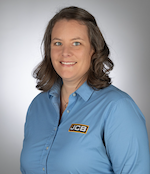 |
| Rebecca Yates Senior Product Manager – Material Handling JCB North America |
The introduction of battery powered equipment allows for expansion into new applications and increases productivity. For example, with zero emissions, the 505-20E can be used indoors, underground or close to food and animals. As well, the 505-20E increases productivity by allowing an operator to perform work during early morning hours or late at night, which are more noise-sensitive times.
For a rental center, it is important to offer a full range of telehandler sizes and capacities for their customers, so it’s important to identify and fill any gaps in telehandler type and size.
The JCB range includes models in four categories: compact, lift and place, tool carrier and rotating telehanders. Each category offers unique and specific functionality to a job site and range in size class and working height.
For example, compact telehandlers offer superior maneuverability in and around tight and congested work areas. Telehandlers in the lift-and-place category work quickly to get materials up to height whereas tool-carrier models offer the benefit of having two machines in one utilizing both forks and a bucket for pushing and digging. Lastly, rotating telehandlers provide a mobility like none other with 360-degree rotation to move materials in all new planes.
Total cost of ownership (TCO) is critical when looking to add any machine to a fleet and includes more than simply the cost of the machine. It considers elements such as parts and service costs as well as the whether the machine includes or has the capability for telematics.
JCB and its dealers are hyper-focused on TCO and work diligently to maximize TCO. Through its dealers, JCB supports rental centers with service to ensure machine downtime is minimized. As well, JCB’s telematics system, JCB LiveLink, provides insights into usage to help with planning maintenance to ensure maximum productivity. It also provides a sense of security through locating functions and even machine alerts.
Providing customers with machines that can do many jobs and use different attachments can help increase demand and ROI for rental centers. For example, the JCB tool-carrier telehandler is designed to use both forks and a bucket so it can be used not only to pick and place palleted materials, but also move gravel or dirt to keep from remaining idle. The operator only needs to rent one machine but will keep it for longer while avoiding added costs of transport and upkeep.
Fleet managers can also utilize telematics like JCB LiveLink to understand if the machine has idle time during certain parts of the day or even confirm when a machine has been parked and ready to be returned and moved on to the next customer.
Ride control improves comfort and productivity
Advances that increase operator confidence and productivity and drive safety improvements on job sites continue to influence JLG and SkyTrak product development.
 |
| John Boehme Senior Product Manager – Telehandlers JLG |
That’s because there are always “jobs to be done,” and JLG engineers are committed to understanding job site challenges and delivering tangible features and functionality that benefit customers. These come from JLG teams watching how telehandlers work on job sites as well as talking with operators that use this type of equipment every day.
One such feature that has come out of our voice-of-the-customer work is ride control. Through our time in the field, the JLG teams discovered that telehandler operators have been searching for a solution that would give precise boom control when paired with a ride control system.
Ride control acts as a spring between the boom and the frame of the machine. It cushions the ride for the load on the forks when the machine is traversing rough terrain. It does not offer any added cushion or comfort for the operator, but it can help improve productivity by reducing damage to the load and allowing operators to quickly move over changing terrain without load stability worries.
When considering adding new model telehandlers into a rental fleet, it is important for rental centers to offer a range of sizes and styles to meet varying job site needs. For example, rental centers should stock models for both pick-and-place or pick-and-carry applications.
Pick-and-place applications require a telehandler to lift the load (pick) and set it in another location (place). Commonly designed with longer booms made up of three to five sections and equipped with outriggers or stabilizers, pick-and-place telehandlers excel at placing materials precisely at greater lift heights and offer more forward reach, two criteria that categorize them as high-reach models.
The ability to place loads with height and outreach give high-reach telehandlers some advantages over more traditional pick-and-place machines, such as cranes and straight-mast forklifts. For example, only cranes used to be able to lift material up 4 to 5 stories into buildings or multi-family residential building. But now, users are able to do that kind of lifting with telehandlers.
The JLG 1075 high-reach telehandler was developed for this specific purpose. It can reach up to eight stories (more than 60 feet) and extend further into a building (more than 30 feet) than existing models to place materials where they are needed, rather than placing them and then reloading them for movement to the work area.
Examples of high-reach pick-and-place applications include:
- Bridge and road work
- General, commercial, industrial and residential construction
- Demolition and renovation
- Entertainment
- Facility maintenance
- Framing
- Steel erection
Pick-and-carry applications require a telehandler to lift/pick the load and move/carry it to another destination, sometimes over fairly long distances.
Because these telehandlers excel at hauling heavier, bulkier materials from point A to point B, pick-and carry models are often bigger machines that are not equipped with outriggers or stabilizers and are generally designed to handle full-capacity loads on the tires. These types of telehandlers are categorized as high-capacity models.
For example, with a 26,600-pound maximum capacity, the JLG 2733 high-capacity telehandler is purpose-built to handle and haul heavy, bulky materials; load and unload trucks and trailers; and help maintenance and repair personnel work on larger fleet equipment.
Examples of high-capacity pick-and-carry applications include:
- Energy exploration
- Equipment maintenance
- Industrial and large-scale commercial construction
- Heavy highway projects
- Large-scale infrastructure work
- Mining and quarries
- Oil and gas refineries
- Pipeline construction
- Stockpile management
- Wind and solar power
Traditionally, cranes or straight-mast forklifts have been used in these types of applications. Because telehandlers now offer a third equipment option, it’s important for rental centers to understand the differences and advantages high-reach and high-capacity models offer.
Increasing the demand and ROI for telehandlers is all about the different types of attachments that can be used on the front of the machines. Telehandlers are called tool carriers for a reason. They can handle a wide range of lifting, hoisting and material-handling applications because of the large variety of attachments ranging from buckets, carriages and truss booms/lift hooks to specialty attachments such as tire handlers. With fork-mounted, coupler-mounted and permanent-mounted attachment options available, operators can use telehandlers for a myriad of tasks by simply changing the attachment. By switching out these tools, telehandlers can be used for more than just lifting applications.
They excel at hoisting and material-handling tasks when equipped with a boom-mounted lifting lug attachment/hook/clevis that allows operators to put a chain or straps through it to efficiently handle and hoist suspended loads.
Understanding the nature of the work to be accomplished and the capabilities of each type of attachment the machine can be fitted with is crucial to a successful rental, as well as safe and efficient use of the machine. Rental centers need to ask their customers whether a load needs to be picked or placed. Does the job require loose material to be scooped or a load suspended? Does the operator need to grapple loose material or pipes? Answering these questions will help rental centers recommend the appropriate size and type of attachments their customers will need to complete the work.
Check out compact units with high lifting capacities
In recent years, three major areas of technology have impacted telescopic handlers: engines, telematics and rear video/sensors.
 |
| Steve Kuskunas Product Manager Manitou Group |
Over the last decade, government regulations forced a greater use of technology to control engine emissions. The benefits of these changes are the newer engines cause less harm to the environment and are more fuel efficient. Telematics have improved equipment fleet operations as the data capture and communication of machine status is leveraged for more efficiency in their rental and equipment maintenance support. Rear video and rear object warning sensors are available for Gehl and Manitou telescopic handlers due to higher levels of customer interest in these systems.
There are several key questions to ask when considering the new telehandler purchase for a rental fleet. With new technology used in the telehandler engines, one question to answer is if high horsepower or low horsepower is needed. Telehandlers with more than 74 horsepower generally require DEF for use, while those at 74 horsepower or below generally do not use DEF.
Most customers will be able to use a lower horsepower machine unless high speed, high torque or work at high altitude is required. For those applications, Manitou experts recommend the higher-horsepower engine units.
Rental centers should also review new telehandler products such as the Manitou ULM or Gehl GCT super compact machines to see if these products can increase their product offering. These new models offer good capacity in a super compact size and a low total vehicle weight for ease of transport.
When reviewing a customer request for a telescopic handler, it is good practice to ask what application and materials the customer plans to use with the machine. This helps in two key areas: First, it makes sure the correct size telescopic handler is rented for the work that needs to be done. In some applications, the 6,000-pound 42-foot machine is a better fit for the work instead of the 8,000 pound 42-foot machine. Finding the correct size machine for the customer takes a little work upfront, but in the end leads to greater customer satisfaction and return business.
The second reason to ask how the telescopic handler will be used is that there may be additional opportunities for the machine to do more work than the customer’s original request. Telescopic handlers are tool carriers and with the correct attachments, the machine can move quickly from placing lumber with a fork carriage to setting trusses with a jib, lift hook or truss boom to moving gravel with a bucket to lifting people in a work platform to access high areas. If additional tasks are performed with the machine, then the rental time is extended and additional rental revenue gained.
Look for practical visibility
Pettibone continues to be the only manufacturer producing a telehandler with a horizontally sliding boom.
 |
|
Mitch Fedie |
All models in the Pettibone Traverse lineup offer up to 70 inches of traversing boom travel. This allows users to safely land loads without having to coordinate multiple boom functions or move the machine physically forward or back, which can be hazardous, particularly on rough terrain.
Telehandler manufacturers are continuing to emphasize safety in many other ways when considering the overall machine design and specific features. Visibility is a big focus. Some telehandlers are promoted as having excellent visibility from the cab, but seemingly clear sightlines can vanish once the machine is put into a real working situation. Ideally, the telehandler’s chassis and boom structures should be designed to provide the best possible visibility in all directions around the machine.
Telehandlers in the Pettibone X-Series lineup use a single lift cylinder, rather than two cylinders, to improve rear sightlines for the operator. Pettibone units also offer an optional rear-view camera system. Larger Pettibone units equipped with outriggers still have good visibility to the fork tips. Additionally, the Pettibone side-mounted engine compartment is situated to allow good curbside visibility.
The other benefit of a side-mounted engine compartment is that it offers easy accessibility for daily service checks. Grease points on X-Series telehandlers are easily reached as well. It’s important to grease telehandlers regularly, as well to check the boom’s wear pads to ensure they’re at the proper tolerance.
While simple maintenance is certainly important for having a rented telehandler work smoothly for the customer, it’s also key for quickly turning the machine around for the next rental. Pettibone’s telehandler cab features an all-steel dash, so rental centers can simply pressure-wash any mud or dirt out of the interior without fear of damaging cab components.
Utilizing telematics software is another good way to increase return on investment. Rental owners now have readily available data that gives basic information such as equipment location. Telematics also help identify any issues occurring with the machine so those items can be addressed before they become serious problems.
Certain issues can be quickly diagnosed using the telematics dashboard on a computer or smartphone app. This is particularly advantageous when a telehandler is on a remote job site. Field technicians can learn more information about the problem before they arrive. Depending on the affected components, telematics can sometimes let repair technicians know the exact part number that needs replacing. Techs can then ensure they have the necessary replacement part before heading to the job site to make the repair.
Many rental customers – even those experienced with telehandlers – aren’t always familiar with a particular brand or model, so it’s possible that operator errors can lead to costly breakdowns. Telematics can produce proper alerts that can go a long way toward proactively ensuring customer uptime and the long-term health of the telehandler.
Pettibone’s X-Command telematics program comes standard for two years on X-Series Extendo and Traverse telehandlers. The system is also available as a retrofit for existing X-Series machines. X-Command allows owners to look at current equipment data and generate reports that can assist with planning fleet maintenance.
Another consideration for rental centers looking to add telehandler units to their fleet is the warranty offered by the manufacturer. Many warranties look similar on the surface, but keep in mind that some may cut off after a certain number of hours of use, while others are good for the full warranty term, regardless of how much they’ve been run.
Look for low downtime
Skyjack’s latest range of telehandlers feature two unique systems. First, a Rear Axle Stabilization (RAS) system that increases stability and provides job site flexibility with three operational modes: normal free pivot, restricted, and locked.
 |
|
Rafael Bazzarella |
Based on the boom’s angle, the RAS system automatically allows the operator to fine-tune adjustments to place the load safely at height without having to lower the load to level the frame and then lift again.
Second, using improved gearing and a high-efficiency hydraulics package, Skyjack’s TH Series’ 74-horsepower engines deliver the same on-site job performance as higher horsepower units. The SmarTorque engine is also engineered to require no DPF, DEF, or other active exhaust aftertreatment, which reduces operating costs.
The latest Skyjack models have increased machine reliability and longevity while continuing to offer best in class serviceability. They feature:
- A new dual-tilt compensation cylinder design that improves load distribution and reliability.
- New maintenance-free (greaseless) main bearings.
- A relocated engine control unit (ECU) for easier service access.
- A new high-pressure filter system and improved hydraulic tank design that significantly reduce contamination.
- New durable and rental yard-repairable steel engine cowling.
- New ergonomic seat with improved weather protection.
When a rental asset is not out on rent, it is not contributing to return on investment. Minimal machine downtime keeps units out on rent longer, earning rental centers more money.
Skyjack became an industry leader by providing machine features that combine durability, quality, and serviceability, making Skyjack products world-renowned for product reliability.
Skyjack telehandlers extend the company principle of simple reliability into material-handling equipment. Skyjack TH Series telehandlers are designed so all major service points are easily accessible, limiting downtime and increasing customer utilization.
With a variety of proprietary features, Skyjack’s TH Series offer the rental industry’s best life cycle value. An example of that approach is represented by an innovative cab design that allows fleet operators to easily convert between open and enclosed cabs with simple hand tools, providing increased flexibility for fleet movement and fast response to customer demands. Bolt-on/off window retention system leads to increased uptime and minimizes costs incurred when replacing glass.
To achieve highest possible ROI, the first consideration is that the machine specifications are right for your customers applications. Skyjack’s range extends from 5,000 to 20,000 pounds capacity and lift heights from 19 to 56 feet. Look for designs that offer the reliability and serviceability to maximize uptime; that ethos is fundamental to the Skyjack range.
Features that increase utilization are important. In the case of Skyjack Flex cab, it provides increased flexibility for fleet movement and fast response to customer demands. The Readyhook yoke-mounted lifting hook is standard on TH Series telehandlers. With capacities that match the maximum lift capability of the telehandler, the hook allows safe under-slinging of loads and avoids the practice of using the forks as an undersling lifting device.
Skyjack’s TH Series telehandlers offer a wide variety of carriages, fork options, and additional attachments designed to increase telehandler productivity to help you tackle the ever-changing jobsites.
Look for full [parts and service support
In today’s market, having the advanced engineering and design that Magni has is not always enough to fulfill customers’ needs; you also have to provide superior safety and take the guesswork out of the operator’s control.
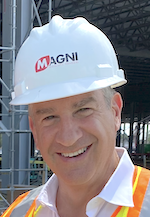 |
|
Gary N. Weisman |
Magni provides the safest telehandler available today by incorporating software that includes a full LMI (Load moment indicator), an active load chart that allows the operator to always understand his or her load and parameters and will even prevent the operator from operating in an unsafe manner.
When taking on a new telehandler line in your rental fleet, rental center managers need the confidence that it has the best machine that will deliver increased ROI. But even more important is the manufacturer having a world-class support system for parts and service. Magni has made significant investments in the U.S. market by opening a major distribution hub for machines, attachments and parts in Pasadena, Texas. It has 42,000 square feet under roof! Magni also provides 24/7 service support for the Magni dealer network with a team of experts that can assist with even the most difficult situations.
By offering Magni products, a rental center can offer its market non-commodity, differentiated machines that offer increased ROI. Magni machines are the easiest to operate in their class and all machines have common components and operating systems that make it possible for customers to get right to work and be efficient.
-30-
This article originally appeared in the July-August 2022 issue of Pro Contractor Rentals magazine. © 2022 Ubain Communications LLC. All rights reserved.








